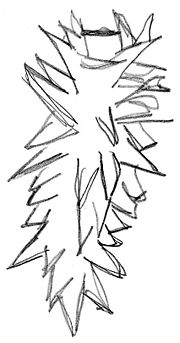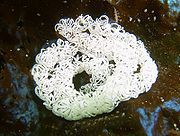Dirona albolineata
From marinelife1011
| Frosted Nudibranch | |
|---|---|
| Scientific classification | |
| Kingdom: | Animalia |
| Phylum: | Mollusca |
| Class: | Gastropoda |
| Order: | Nudibranchia |
| Family: | Arminidea |
| Genus: | Dirona |
| Species: | albonineata |
| Binomial name | |
| Dirona albolineata Linnaeus, 1758 |
|
Common names: The White or Frosted Nudibranch, White Lined Dirona, Chalk lined Dirona, White Streaked Dirona [1]
From latin name Nudus- naked
Nudibranchs are an indicator species, showing the health of the environment they live in.
Contents |
Description
Morphology Dirona albolineata is a pink or white translucent sea slug with out a shell. It has dominate plate-like cerata projecting off its body. These cerata are white along the edges and at the tips. This is what seperates it the most from other nudibranchs. These cerata are flat and pointed and cover the whole body. The gills of this nudibranch can be found under the mantle and are used for respiration. D. albolineata also have a pair of sensory organs called rhinophores on their head. The adults measure up to 20-600 mm in length. Nudibranchs travel around on a "foot", which is a muscle that is used only for transportation. The foot has a sticky mucus for traction on rocky surfaces. Contracting in a wave-like motion from posterior to anterior, the nudibranch is allowed to project in a forward motion. [2]
Evolutionary history
Because nudibranchs are soft bodied they do not have much of a fossil record. Scientists have looked as some of their shelled relatives and the ages of some other evolutionary lineages that nudibranchs have in common with, and believe them to be 150 to 180 million years old. Nudibranchs have lost their shell that their ancestors possess and have acquired powerful toxic chemicals that they take from the food they consume.
Natural History: The cerata of this animal fall off the body easily when being attacked. This animal uses its strong jaw to crack shells of small snails. D. albolineata also feeds on sponges, hydroids, and other bryozoans. [2]
Diet
A variety of invertebrates including snails, and bryozoans [3]
Parasites
Parasties are commonly found and documented in the frosted nudibranch. Dirona albolineata are susceptible to copepod parasites, which make their way into the host and then lay their own eggs. These eggs stream off the Dirona albolineata's body. This parasite has been documented to kill the frosted nudibranch. [4]
Ecology and Distribution
Geological Range
California to Alaska, areas of British Columbia, Japan, and Russia
Habitat/depth range intertidal to 50 meters in depth
substrate: bedrock, boulders, etc.
Behavior
Defences D. alblineata does not eat anemones and because of this, does not incorporate the stinging cells into their cerata for protection. Instead, when being attacked or in danger, they will shed their cerata and flee from its predators. These cerata are then regenerated after falling off the body. In regards to chemical defences, not much is known about this family imparticutlar, but many other families of nudibranchs use chemicals as a defence.
Reproduction D. albolineata are hermaphrodites, having both male and female reproductive organs. Even though they possess both female and male sex organs, they rarely engage in self-fertilization. Mating occurs with the courting individual positioning themselves in a head to tail orientation so that the genitalia are lined up. There eggs are deposited in a ribbon-like cluster on the substrate. Nudibranchs lay hundreds of thousands to millions of eggs to ensure that young make it to adulthood. After the eggs hatch they enter the plankton stage of their life. Nudibranchs life span is about 6 months to a one year.
Common Frosted Nudibranch Misconceptions
There are a few different families of Nudibranch. They include, Doridea, Aeolidea, Dendronotidea, Cephalaspidea, and Arminidea. D. albonlineata is in the family Arminidea, but can be commonly confused with the family Aeolidea. The Arminidea is the smallest family of nudibranch in the Northwest. The placement of the gills is what most differentiates these two families. Some gills have been found on the backs of nudibranchs, but in the case of D. albonlineata, there gills can be found under their mantle.
Links
External links/video:http://www.youtube.com/watch?v=hLvhpsvWHVY
References
Intertidal Marine Invertebrates of the South Puget Sound, Jennifer Tenlack, Melissa Phipps, http://www.nwmarinelife.com/htmlswimmers/d_albolineata.html Balanced Environmental, http://www.balanced.ca/hd/nudibranch.html Frosted Sea Slug Zooology (Oregon), Memutic, 2009, http://www.youtube.com/watch?v=hLvhpsvWHVY Kitsap Sun, Jeff Adams, http://pugetsoundblogs.com/sea-life/category/the-spineless/ Pacific Maine Imaging, Scott Stevenson, http://www.8arm.com/~8arm/photo_albums.html?album_id=754&group_id= Florida Fish and Wildlife Research Institute, http://research.myfwc.com/features/view_article.asp?id=35340 Behrens, D.W., 2008 (Nov 25). Comment on Infested Dirona albolineata from British Columbia by Marli Wakeling. [Message in] Sea Slug Forum. Australian Museum, Sydney. Available from http://www.seaslugforum.net/find/22038




